Reference Evapotranspiration in Climate Change Scenarios in Mato Grosso, Brazil
Abstract
1. Introduction
2. Materials and Methods
2.1. Study Area and Data Acquisition
2.2. Reference Evapotranspiration (ETo) Estimates
2.3. Assessment of Estimation Errors and Choice of GCM
2.4. Spatiotemporal Analysis and Average Test of Reference Evapotranspiration Projections
3. Results and Discussion
3.1. Choice of Climate Projection Models
3.2. Reference Evapotranspiration Climate Projections (ETo)
3.3. Trends Analysis
4. Conclusions
Author Contributions
Funding
Data Availability Statement
Conflicts of Interest
Appendix A
| AWS | AWS Name | Biome | Latitude (°) | Longitude (°) | Altitude (m) |
|---|---|---|---|---|---|
| A-901 | Cuiabá | Cerrado | −15.56 | −56.06 | 242 |
| A-902 | Tangará da Serra | Amazon | −14.65 | −57.43 | 440 |
| A-903 | São José do Rio Claro | Cerrado-Amazon | −13.45 | −56.68 | 340 |
| A-904 | Sorriso | Cerrado-Amazon | −12.56 | −55.72 | 379 |
| A-905 | Campo Novo do Parecis | Cerrado | −13.79 | −57.84 | 525 |
| A-906 | Guarantã do Norte | Amazon | −9.95 | −54.90 | 284 |
| A-907 | Rondonópolis | Cerrado | −16.46 | −54.58 | 290 |
| A-908 | Água Boa | Cerrado | −14.02 | −52.21 | 440 |
| A-910 | Apiacás | Amazon | −9.56 | −57.39 | 218 |
| A-912 | Campo Verde | Cerrado | −15.53 | −55.14 | 748 |
| A-913 | Comodoro | Cerrado | −13.71 | −59.76 | 577 |
| A-914 | Juara | Amazon | −11.28 | −57.53 | 263 |
| A-915 | Paranatinga | Cerrado | −14.42 | −54.04 | 477 |
| A-916 | Querência | Amazon | −12.63 | −52.22 | 361 |
| A-917 | Sinop | Cerrado-Amazon | −11.98 | −55.57 | 367 |
| A-918 | Confresa | Cerrado-Amazon | −10.64 | −51.57 | 233 |
| A-919 | Cotriguaçu | Amazon | −9.91 | −58.57 | 265 |
| A-920 | Juína | Amazon | −11.38 | −58.77 | 365 |
| A-921 | São Felix do Araguaia | Cerrado | −11.62 | −50.73 | 201 |
| A-922 | Vila Bela da Santíssima Trindade | Amazon | −15.06 | −59.87 | 213 |
| A-924 | Alta Floresta | Amazon | −10.08 | −56.18 | 292 |
| A-926 | Carlinda | Amazon | −9.97 | −55.83 | 294 |
| A-927 | Brasnorte (Novo Mundo) | Cerrado-Amazon | −12.52 | −58.23 | 426 |
| A-928 | Nova Maringá | Cerrado-Amazon | −13.04 | −57.09 | 334 |
| A-929 | Nova Ubiratã | Cerrado-Amazon | −13.41 | −54.75 | 466 |
| A-930 | Gaúcha do Norte | Cerrado-Amazon | −13.18 | −53.26 | 376 |
| A-931 | Santo Antônio do Leste | Cerrado | −14.93 | −53.88 | 664 |
| A-932 | Guiratinga | Cerrado | −16.34 | −53.77 | 525 |
| A-933 | Itiquira | Cerrado | −17.17 | −54.50 | 593 |
| A-934 | Alto Taquari | Cerrado | −17.84 | −53.29 | 862 |
| A-935 | Porto Estrela | Cerrado | −15.32 | −57.23 | 148 |
| A-936 | Salto do Céu | Amazon | −15.12 | −58.13 | 301 |
| A-937 | Pontes de Lacerda | Amazon | −15.23 | −59.35 | 273 |
References
- Trebicki, P. Climate change and plant virus epidemiology. Virus Res. 2020, 286, e198059. [Google Scholar] [CrossRef] [PubMed]
- Kogo, B.K.; Kumar, L.; Koech, R. Climate change and variability in Kenya: A review of impacts on agriculture and food security. Environ. Dev. Sustain. 2021, 23, 23–43. [Google Scholar] [CrossRef]
- Garrett, K.A.; Nita, M.; De Wolf, E.D.; Esker, P.D.; Gomez-Montano, L.; Sparks, A.H. Plant pathogens as indicators of climate change. In Climate Change: Observed Impacts on Planet Earth; Letcher, T., Ed.; Elsevier: Amsterdam, The Netherlands, 2021; pp. 499–513. [Google Scholar] [CrossRef]
- Intergovernmental Panel on Climate Change (IPCC). Climate Change 2014: Contribution of Working Groups I, II and III to the Fifth Assessment Report of the Intergovernmental Panel on Climate Change; IPCC: Geneva, Switzerland, 2014; 151p. [Google Scholar] [CrossRef]
- Zhao, L.; Xia, J.; Sobkowiak, L.; Li, Z. Climatic Characteristics of Reference Evapotranspiration in the Hai River Basin and Their Attribution. Water 2014, 6, 1482–1499. [Google Scholar] [CrossRef]
- Xiang, K.; Li, Y.; Horton, R.; Feng, H. Similarity and difference of potential evapotranspiration and reference crop evapotranspiration—A review. Agric. Water Manag. 2020, 232, 106043. [Google Scholar] [CrossRef]
- Sarnighausen, V.C.R.; Gomes, F.G.; Dal Pai, A.; Rodrigues, S.A. Estimation of reference evapotranspiration by multiple linear regression models for Botucatu—SP. Rev. Bras. Climatol. 2021, 28, 766–787. [Google Scholar] [CrossRef]
- Patle, G.T.; Sengdo, D.; Tapak, M. Trends in major climatic parameters and sensitivity of evapotranspiration to climatic parameters in the eastern Himalayan region of Sikkim, India. J. Water Clim. Chang. 2019, 11, 491–502. [Google Scholar] [CrossRef]
- Maeda, E.E.; Ma, X.; Wagner, F.H.; Kim, H.; Oki, T.; Eamus, D.; Huete, A. Evapotranspiration seasonality across the Amazon Basin. Earth Syst. Dyn. 2017, 8, 439–454. [Google Scholar] [CrossRef]
- Allen, R.G.; Pereira, L.S.; Raes, D.; Smith, M. Crop Evapotranspiration: Guidelines for Computing Crop Water Requirements; FAO: Rome, Italy, 1998; 300p. [Google Scholar]
- Chen, S.B.; Liu, Y.F.; Thomas, A. Climatic change on the Tibetan Plateau: Potential evapotranspiration trends from 1961–2000. Clim. Chang. 2006, 76, 291–319. [Google Scholar] [CrossRef]
- Kousari, M.R.; Ahani, H. An investigation on reference crop evapotranspiration trend from 1975 to 2005 in Iran. Int. J. Climatol. 2012, 32, 2387–2402. [Google Scholar] [CrossRef]
- Jun, W.; Xinhua, W.; Meihua, G.; Xuyan, X.U. Impact of climate change on reference crop evapotranspiration in Chuxiong City, Yunnan Province. Procedia Earth Planet. Sci. 2012, 5, 113–119. [Google Scholar] [CrossRef]
- Zhang, Y.; Liu, C.; Tang, Y.; Yang, Y. Trends in pan evaporation and reference and actual evapotranspiration across the Tibetan plateau. J. Geophys. Res. 2007, 112, 1–12. [Google Scholar] [CrossRef]
- Liu, X.W.; Shao, L.W.; Sun, H.Y.; Chen, S.Y.; Zhang, X.Y. Responses of yield and water use efficiency to irrigation amount decided by pan evaporation for winter wheat. Agric. Water Manag. 2013, 129, 173–180. [Google Scholar] [CrossRef]
- Sun, S.; Chen, H.S.; Wang, G.J.; Li, J.J.; Mu, M.Y.; Yan, G.X.; Xu, B.; Huang, J.; Wang, J.; Zhang, F.M.; et al. Shift in potential evapotranspiration and its implications for dryness/wetness over Southwest China. J. Geophys. Res. Atmos. 2016, 121, 9342–9355. [Google Scholar] [CrossRef]
- Lima, J.W.M.; Collischonn, W.; Marengo, J.A. Effect of Climate Change on Electricity Generation; AES Tietê: São Paulo, Spain, 2014; 360p. [Google Scholar]
- Sampaio, G.; Dias, P.L.S. Evolution of climate and weather and climate forecast models. Rev. USP 2014, 1, 41–54. [Google Scholar] [CrossRef]
- Taylor, K.E.; Stouffer, R.J.; Meehl, G.A. An overview of CMIP5 and the experiment design. Bull. Am. Meteorol. Soc. 2012, 93, 485–498. [Google Scholar] [CrossRef]
- Raju, K.S.; Kumar, D.N. Review of approaches for selection and ensembling of GCMs. J. Water Clim. Chang. 2020, 11, 577–599. [Google Scholar] [CrossRef]
- Dentz, E.V. Agricultural production in the State of Mato Grosso and the relationship between agribusiness and cities: The case of Lucas do Rio Verde and Sorriso. Ateliê Geogr. 2019, 13, 165–186. [Google Scholar] [CrossRef]
- Tanaka, A.A.; Souza, A.P.; Klar, A.E.; Silva, A.C.; Gomes, A.W.A. Reference evapotranspiration estimated with simplified models for the state of Mato Grosso, Brazil. Pesqui. Agropecu. Bras. 2016, 51, 91–104. [Google Scholar] [CrossRef][Green Version]
- D’Acunha, B.; Dalmagro, H.J.; Arruda, P.H.Z.; Biudes, M.S.; Lathuillière, M.J.; Uribe, M.; Couto, E.G.; Brando, P.M.; Vourlitis, G.; Johnson, M.S. Changes in evapotranspiration, transpiration and evaporation across natual and managed landscapes in the Amazon, Cerrado and Pantanal biomes. Agric. For. Meteorol. 2024, 346, 109875. [Google Scholar] [CrossRef]
- Biudes, M.S.; Geli, H.M.E.; Vourlitis, G.L.; Machado, N.G.; Pavão, V.M.; Santos, L.O.F.; Querino, C.A.S. Evapotranspiration seasonality over tropical ecosystems in Mato Grosso, Brazil. Remote Sens. 2022, 14, 2482. [Google Scholar] [CrossRef]
- Souza, A.P.; Mota, L.L.; Zamadei, T.; Martim, C.C.; Almeida, F.T.; Paulino, J. Climate classification and climatic water balance in Mato Grosso state, Brazil. Nativa 2013, 1, 34–43. [Google Scholar] [CrossRef]
- Alvares, C.A.; Stape, J.L.; Sentelhas, P.C.; Gonçalves, J.D.M.; Sparovek, G. Köppen’s climate classification map for Brazil. Meteorol. Z. 2013, 22, 711–728. [Google Scholar] [CrossRef] [PubMed]
- Copernicus Climate Change Service. Climate Data Store: In Situ Total Column Ozone and Ozone Soundings from 1924 to Present from the World Ozone and Ultraviolet Radiation Data Centre; Copernicus Climate Change Service (C3S) Climate Data Store (CDS). Reading/United Kingdom, Bologna/Italy and Bonn/Germany: European Centre for Medium-Range Weather Forecast (ECMRWF). 2021. [Google Scholar] [CrossRef]
- Reichle, R.H.; Koster, R.D. Bias Reduction in Short Records of Satellite Soil Moisture. Geophys. Res. Lett. 2004, 31, L19501. [Google Scholar] [CrossRef]
- Brocca, L.; Hasenauer, S.; Lacava, T.; Melone, F.; Moramarco, T.; Wagner, W.; Dorigo, W.; Matgen, P.; Martínez-Fernández, J.; Llorens, P.; et al. Soil Moisture Estimation through ASCAT and AMSR-E Sensors: An Intercomparison and Validation Study across Europe. Remote Sens. Environ. 2011, 115, 3390–3408. [Google Scholar] [CrossRef]
- Ali, G.; Sajjad, M.; Kanwal, S.; Xiao, T.; Khalid, S.; Shoaib, F.; Gul, H.N. Spatial–temporal characterization of rainfall in Pakistan during the past half-century (1961–2020). Sci. Rep. 2021, 11, 6935. [Google Scholar] [CrossRef] [PubMed]
- Krivoruchko, K.; Gribov, A.; Krause, E. Multivariate areal interpolation for continuous and count data. Procedia Environ. Sci. 2011, 3, 14–19. [Google Scholar] [CrossRef]
- Mann, H.B. Non-parametric test against trend. Econometrika 1945, 13, 245–259. [Google Scholar] [CrossRef]
- Kendall, M.G. Rank Correlation Methods; Griffin: London, UK, 1997; 202p. [Google Scholar]
- Sabino, M.; Souza, A.P. Gap-filling meteorological data series using the GapMET software in the state of Mato Grosso, Brazil. Rev. Bras. Eng. Agríc. E Ambient. 2023, 27, 149–156. [Google Scholar] [CrossRef]
- Sen, P.K. Estimates of the regression coefficient based on Kendall’s Tau. J. Am. Stat. Assoc. 1968, 63, 1379–1389. [Google Scholar] [CrossRef]
- Mueller, B.; Hirschi, M.; Jimenez, C.; Ciais, P.; Dirmeyer, P.A.; Dolman, A.J.; Fisher, J.B.; Jung, M.; Ludwig, F.; Maignan, F.; et al. Benchmark products for land evapotranspiration: LandFlux-EVAL multi-data set synthesis. Hydrol. Earth Syst. Sci. 2013, 17, 3707–3720. [Google Scholar] [CrossRef]
- Zhang, K.; Kimball, J.S.; Nemani, R.R.; Running, S.W.; Hong, Y.; Gourley, J.J.; Yu, Z. Vegetation greening and climate change promote multidecadal rises of global land evapotranspiration. Sci. Rep. 2015, 5, 15956. [Google Scholar] [CrossRef] [PubMed]
- Gulizia, C.; Camilloni, I. Comparative analysis of the ability of a set of CMIP3 and CMIP5 global climate models to represent precipitation in South America. Int. J. Climatol. 2015, 35, 583–595. [Google Scholar] [CrossRef]
- Martins, G.; Silva, C.M.S. Estimate of water balance of the Amazon basin at the end of the first half XXI century using the simulations of CMIP5. Bol. Geogr. 2015, 33, 1–16. [Google Scholar] [CrossRef]
- Guimarães, S.O.; Costa, A.A.; Vasconcelos Júnior, F.D.C.; Silva, E.M.D.; Sales, D.C.; Araújo Júnior, L.M.D.; Souza, S.G.D. Climate change projections over the Brazilian Northeast of the CMIP5 and CORDEX Models. Rev. Bras. Meteorol. 2016, 31, 337–365. [Google Scholar] [CrossRef]
- Silva, R.O.; Souza, E.B.; Tavares, A.L.; Mota, J.A.; Ferreira, D.; Souza-Filho, P.W.; Rocha, E.J.D. Three decades of reference evapotranspiration estimates for a tropical watershed in the eastern Amazon. An. Acad. Bras. Ciênc. 2017, 89, 1985–2002. [Google Scholar] [CrossRef] [PubMed]
- Rocha, V.M.; Correia, F.W.S.; Chou, S.C.; Lyra, A.; Silva, P.R.T.; Gomes, W.B.; Vergasta, L. Evaluation of the water budget in the Amazon basin simulated by the ETA-HADGEM2-es model from 1985 to 2005. Rev. Geogr. 2016, 33, 276–298. [Google Scholar]
- Gomes, W.W.E.; Leite Filho, A.T.; Soares-Filho, B.S. Simulation of the impacts of global climate change on reference evapotranspiration in the Brazilian Amazon basin. Rev. Bras. Climatol. 2021, 28, 450–470. [Google Scholar] [CrossRef]
- Sabino, M.; Souza, A.P. Global sensitivity of Penman-Monteith reference Evapotranspiration to climatic variables in Mato Grosso, Brazil. Earth 2023, 4, 714–727. [Google Scholar] [CrossRef]
- Chou, C.; Lan, C.W. Changes in the annual range of precipitation under global warming. J. Clim. 2012, 25, 222–235. [Google Scholar] [CrossRef]
- Chou, C.; Chiang, J.C.; Lan, C.W.; Chung, C.H.; Liao, Y.C.; Lee, C.J. Increase in the range between wet and dry season precipitation. Nat. Geosci. 2013, 6, 263–267. [Google Scholar] [CrossRef]
- Konapala, G.; Mishra, A.K.; Wada, Y.; Mann, M.E. Climate change will affect global water availability through compounding changes in seasonal precipitation and evaporation. Nat. Commun. 2020, 11, e3044. [Google Scholar] [CrossRef] [PubMed]
- Richter, I.; Xie, S.P. Muted precipitation increase in global warming simulations: A surface evaporation perspective. J. Geophys. Res. Atmos. 2008, 113, 1–20. [Google Scholar] [CrossRef]
- Greve, P.; Seneviratne, S.I. Assessment of future changes in water availability and aridity. Geophys. Res. Lett. 2015, 42, 5493–5499. [Google Scholar] [CrossRef] [PubMed]
- Werth, D.; Avissar, R. The regional evapotranspiration of the Amazon. J. Hydrometeorol. 2004, 5, 100–109. [Google Scholar] [CrossRef]
- Grimm, A.M.; Barros, V.R.; Doyle, M.E. Climate variability in southern South America associated with El Niño and La Niña events. J. Clim. 2000, 13, 35–58. [Google Scholar] [CrossRef]
- Mantua, N.J.; Hare, S.R.; Zhang, Y.; Wallace, J.M.; Francis, R.C. A Pacific interdecadal climate oscillation with impacts on salmon production. Bull. Am. Meteorol. Soc. 1997, 78, 1069–1079. [Google Scholar] [CrossRef]
- Terink, W.; Immerzeel, W.W.; Droogers, P. Climate change projections of precipitation and reference evapotranspiration for the Middle East and northern Africa until 2050. Int. J. Climatol. 2013, 33, 3055–3072. [Google Scholar] [CrossRef]
- Tao, X.; Chen, H.; Xu, C.-Y.; Hou, Y.K.; Jie, M. Analysis and prediction of reference evapotranspiration with climate change in Xiangjiang River Basin, China. Water Sci. Eng. 2015, 8, 273–281. [Google Scholar] [CrossRef]
- Jiao, L.; Wang, D. Climate change, the evaporation paradox, and their effects on Streamflow in Lijiang Watershed. Pol. J. Environ. Stud. 2018, 27, 2585–2591. [Google Scholar] [CrossRef]
- Shan, N.; Shi, Z.; Yang, X.; Zhang, X.; Guo, H.; Zhang, B.; Zhang, Z. Trends in potential evapotranspiration from 1960 to 2013 for a desertification-prone region of China. Int. J. Climatol. 2016, 36, 3434–3445. [Google Scholar] [CrossRef]
- Obada, E.; Alamou, E.; Chabi, A.; Zandagba, J.; Afouda, A. Trends and changes in recent and future Penman-Monteith potential evapotranspiration in Benin (West Africa). Hydrology 2017, 4, e38. [Google Scholar] [CrossRef]
- Rahman, M.A.; Yunsheng, L.; Sultana, N.; Ongoma, V. Analysis of reference evapotranspiration (ET0) trends under climate change in Bangladesh using observed and CMIP5 data sets. Meteorol. Atmos. Phys. 2018, 131, 639–655. [Google Scholar] [CrossRef]
- Zhao, J.; Xia, H.; Yue, Q.; Wang, Z. Spatiotemporal variability in reference to evapotranspiration and its contributing climatic factors in China under future scenarios. Int. J. Climatol. 2020, 40, 3813–3831. [Google Scholar] [CrossRef]
- Peterson, T.C.; Golubev, V.S.; Groisman, P.Y. Evaporation losing its strength. Nature 1995, 377, 687–688. [Google Scholar] [CrossRef]
- Lawrimore, J.H.; Peterson, T.C. Pan Evaporation Trends in Dry and Humid Regions of the United States. J. Hydrometeorol. 2000, 1, 543–646. [Google Scholar] [CrossRef]
- Mahyoub, H.; Buhairi, A. Analysis of monthly, seasonal and annual air temperature variability and trends in Taiz City Republic of Yemen. J. Environ. Prot. 2010, 1, 401–409. [Google Scholar] [CrossRef]
- Zhang, T.; Chen, Y.; Kyaw Tha Paw, U. Quantifying the impact of climate variables on reference evapotranspiration in Pearl River Basin, China. Hydrol. Sci. J. 2019, 64, 1944–1956. [Google Scholar] [CrossRef]
- Yesilirmak, E. Temporal changes of warm-season pan evaporation in a semi-arid basin in Western Turkey. Stoch. Environ. Res. Risk Assess. 2013, 27, 311–321. [Google Scholar] [CrossRef]
- Ozdogan, M.; Salvuccci, G.D. Irrigation-induced changes in potential evapotranspiration in southeastern Trukey: Test and application of Bouchet’s complementary hypothesis. Water Resour. Res. 2004, 40, 1–12. [Google Scholar] [CrossRef]
- Roderick, M.L.; Farquhar, G. Changes in Australian Pan Evaporation from 1970 to 2002. Int. J. Climatol. 2004, 24, 1077–1090. [Google Scholar] [CrossRef]
- Ndiaye, P.M.; Bodian, A.; Diop, L.; Deme, A.; Dezetter, A.; Djaman, K.; Ogilvie, A. Trend and sensitivity analysis of reference evapotranspiration in the Senegal river basin using NASA meteorological data. Water 2020, 12, e1957. [Google Scholar] [CrossRef]
- Shadmani, M.; Marofi, S.; Roknian, M. Trend Analysis in reference to evapotranspiration using Mann-Kendall and Spearman’s Rho tests in arid regions of Iran. Water Resour. Manag. 2012, 26, 211–224. [Google Scholar] [CrossRef]
- Roderick, M.L.; Farquhar, G.D. The Cause of Decreased Pan Evaporation over the Past 50 Years. Science 2002, 298, 1410–1411. [Google Scholar] [CrossRef] [PubMed]
- Han, S.; Xu, D.; Wang, S. Decreasing potential evaporation trends in China from 1956 to 2005: Accelerated in regions with significant agricultural influence? Agric. For. Meteorol. 2012, 154, 44–56. [Google Scholar] [CrossRef]
- Chattopadhyay, N.; Hulme, M. Evaporation and potential evapotranspiration in India under conditions of recent and future climate change. Agric. For. Meteorol. 1997, 87, 55–73. [Google Scholar] [CrossRef]
- Palácios, R.D.S.; Castagna, D.; Barbosa, L.S.; Souza, A.P.; Imbiriba, B.; Zolin, C.A.; Nassarden, D.; Duarte, L.; Morais, F.G.; Franco, M.A.; et al. ENSO effects on the relationship between aerosols and evapotranspiration in the south of the Amazon biome. Environ. Res. 2024, 250, e118516. [Google Scholar] [CrossRef] [PubMed]
- Palácios, R.D.S.; Artaxo, P.; Cirino, G.G.; Nakale, V.; Morais, F.G.D.; Rothmund, L.D.; Biudes, M.S.; Machado, N.G.; Curado, L.F.A.; Marques, J.B.; et al. Long-term measurements of aerosol optical properties and radiative forcing (2011–2017) over Central Amazonia. Atmósfera 2022, 35, 143–163. [Google Scholar] [CrossRef]
- Palácios, R.D.S.; Romera, K.S.; Curado, L.F.A.; Banga, N.M.; Rothmund, L.D.; Da Silva Sallo, F.; MoraiS, D.; Santos, A.C.A.; Moraes, T.J.; Morais, F.G.; et al. Long term analysis of optical and radiative properties of aerosols in the Amazon Basin. Aerosol Air Qual. Res. 2020, 20, 139–154. [Google Scholar] [CrossRef]
- Martel, J.-L.; Brissette, F.; Troin, M.; Arsenault, R.; Chen, J.; Su, T.; Lucas-Picher, P. CMIP5 and CMIP6 model projection comparision for hydrological impacts over North America. Geophys. Res. Lett. 2022, 49, e2022GL098364. [Google Scholar] [CrossRef]
- Lei, Y.; Chen, J.; Xiong, L. A comparision of CMIP5 and CMIP6 climate model projections for hydrological impacots in China. Hydrol. Res. 2023, 54, 330–347. [Google Scholar] [CrossRef]
- Verma, S.; Kumar, K.; Verma, M.K.; Prasad, A.D.; Mehta, D.; Rathanayake, U. Comparative analysis of CMIP5 and CMIP6 in conjunction with the hydrological processo f reservoir catchment, Chhattisgarh, India. J. Hydrol. Reg. Stud. 2023, 50, e101533. [Google Scholar] [CrossRef]
- Van Doi, M.; Kim, J. Future projections and uncertainties of CMIP6 for hydrological indicators and their discrepancies form CMIP5 over South Korea. Water 2022, 14, e2926. [Google Scholar] [CrossRef]
- Wu, Y.; Miao, C.; Slater, L.; Fan, X.; Chai, Y.; Sorooshian, S. Hydrological projections under CMIP5 and CMIP6: Sources and magnitudes of uncertainty. Bull. Am. Meteorol. Soc. 2024, 150, e59–e74. [Google Scholar] [CrossRef]
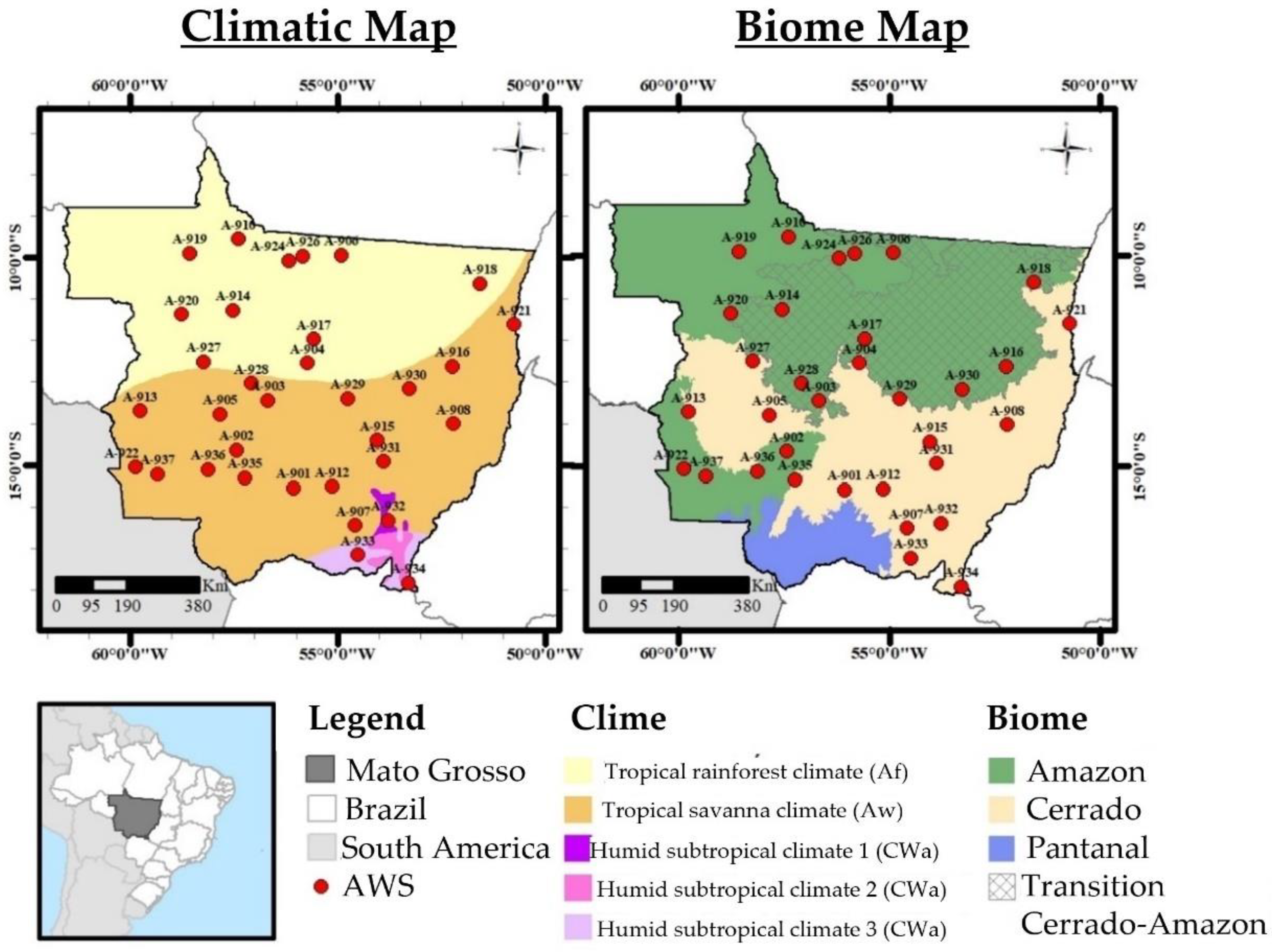
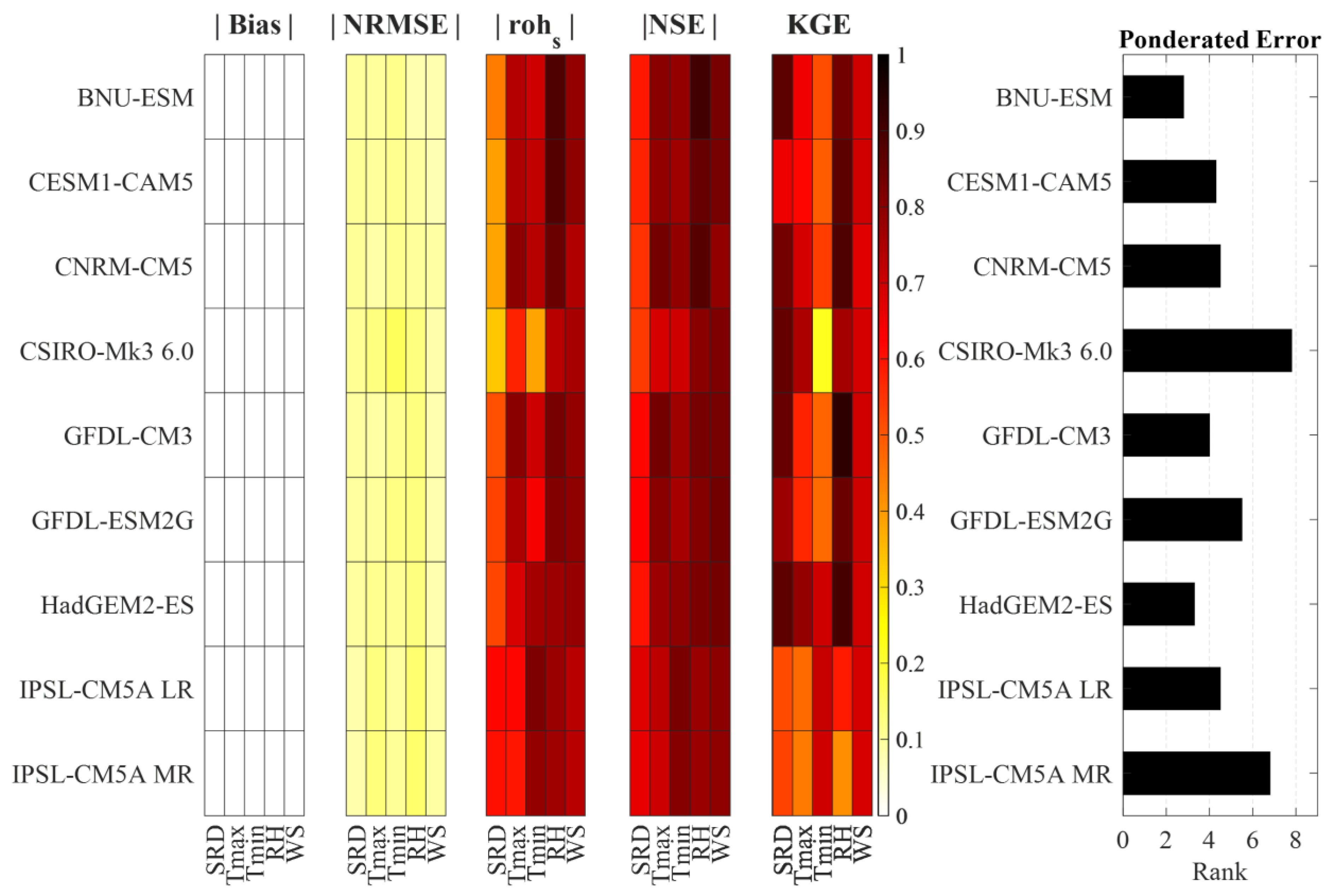
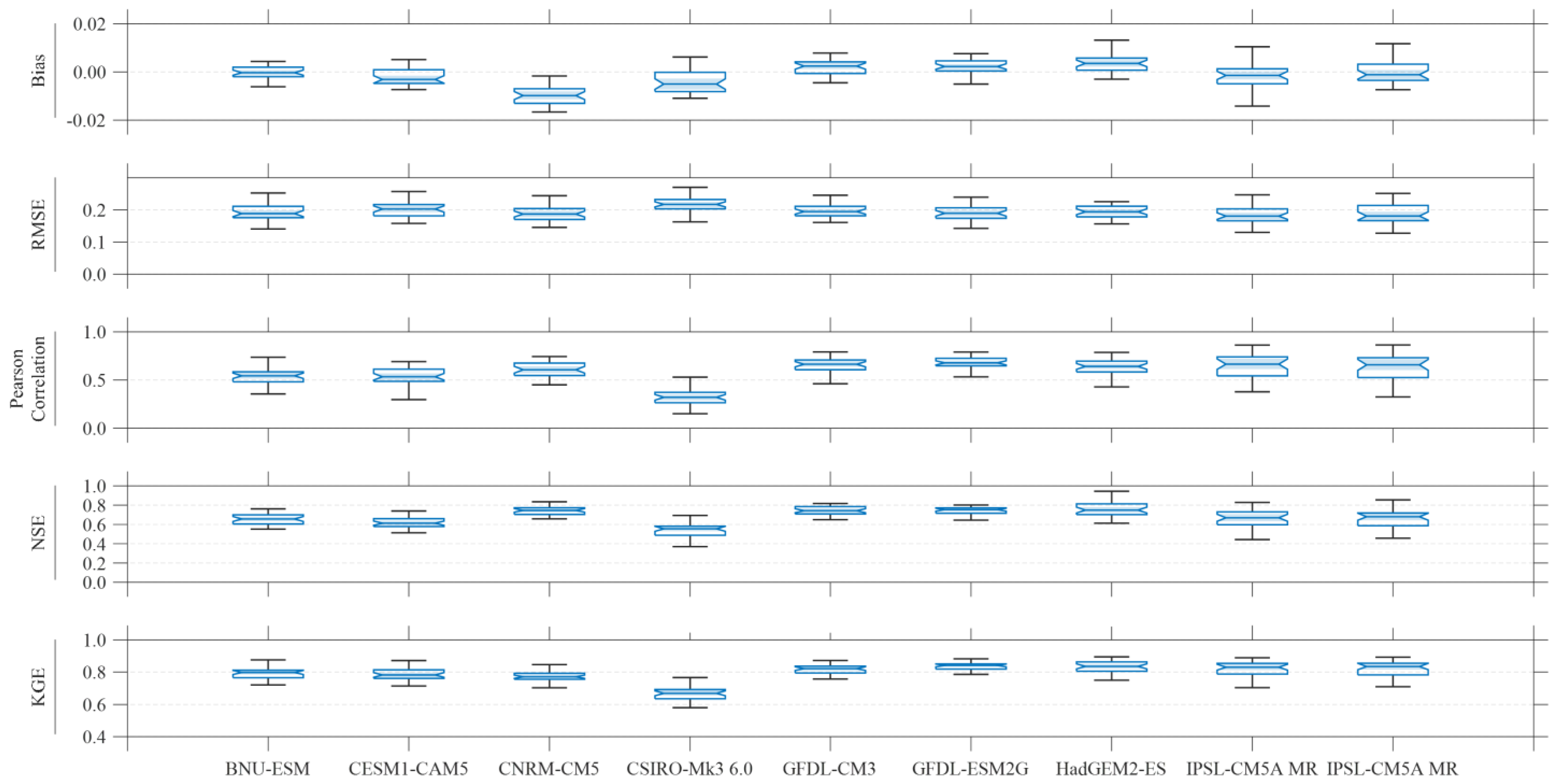

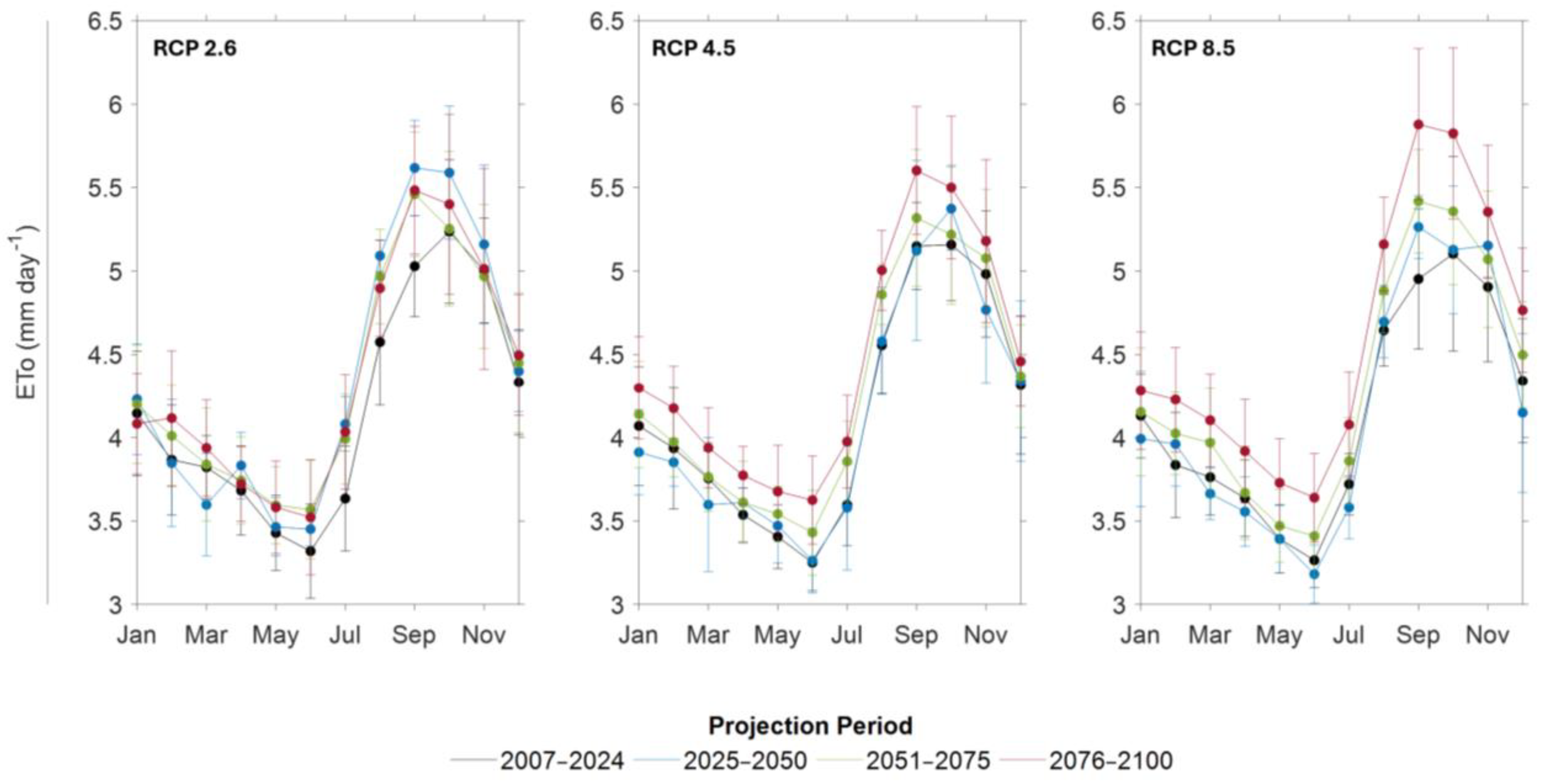
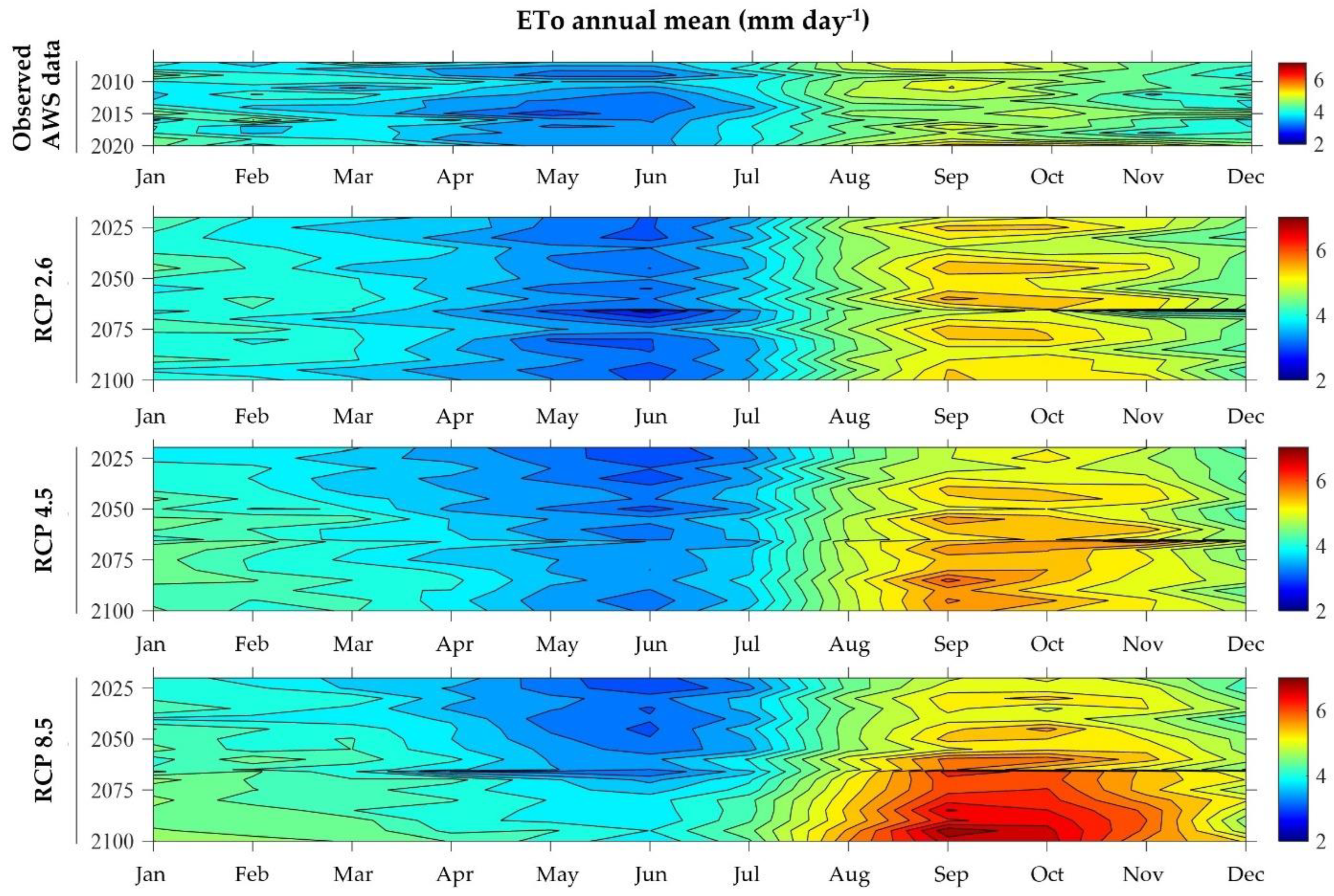
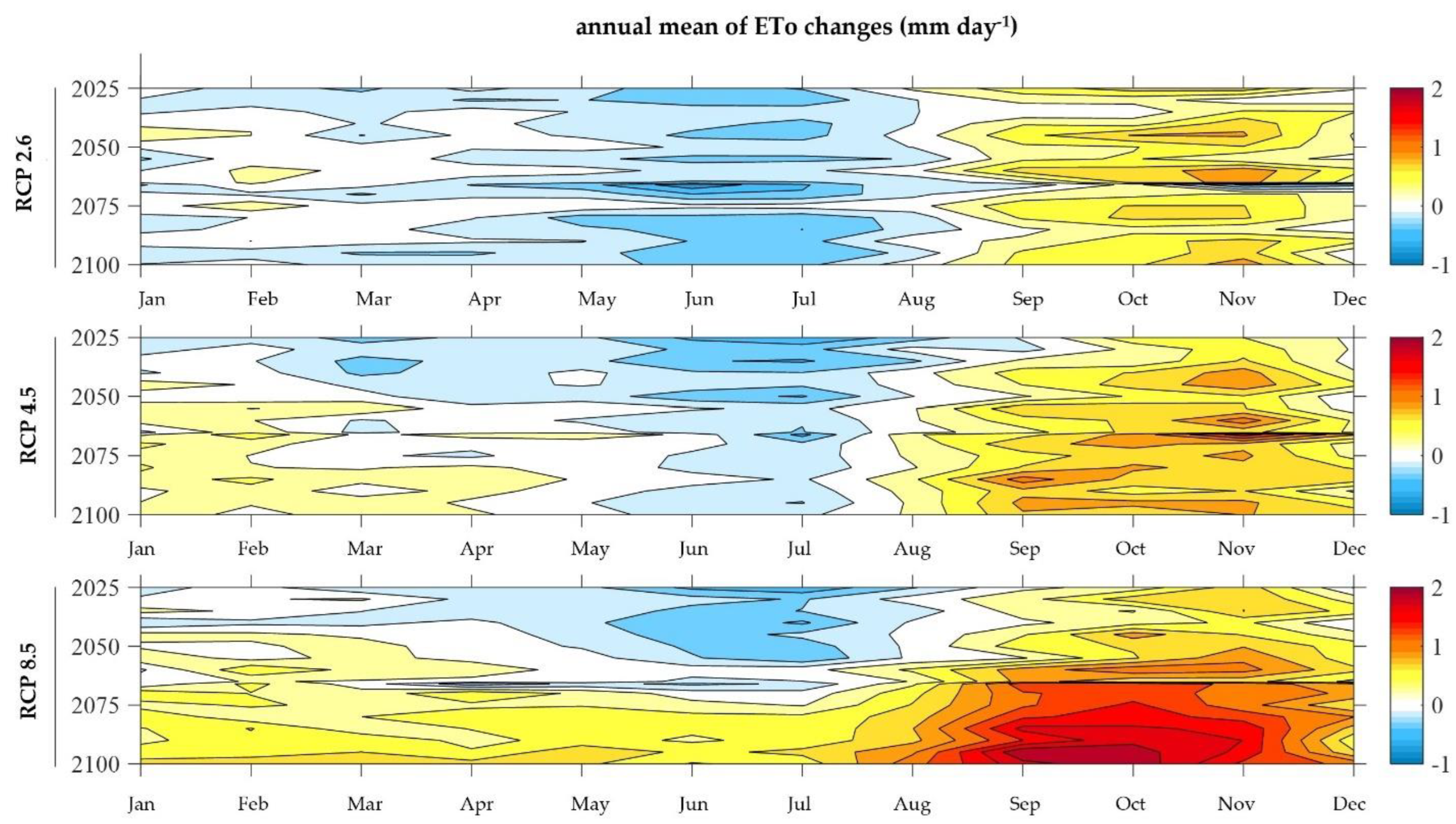
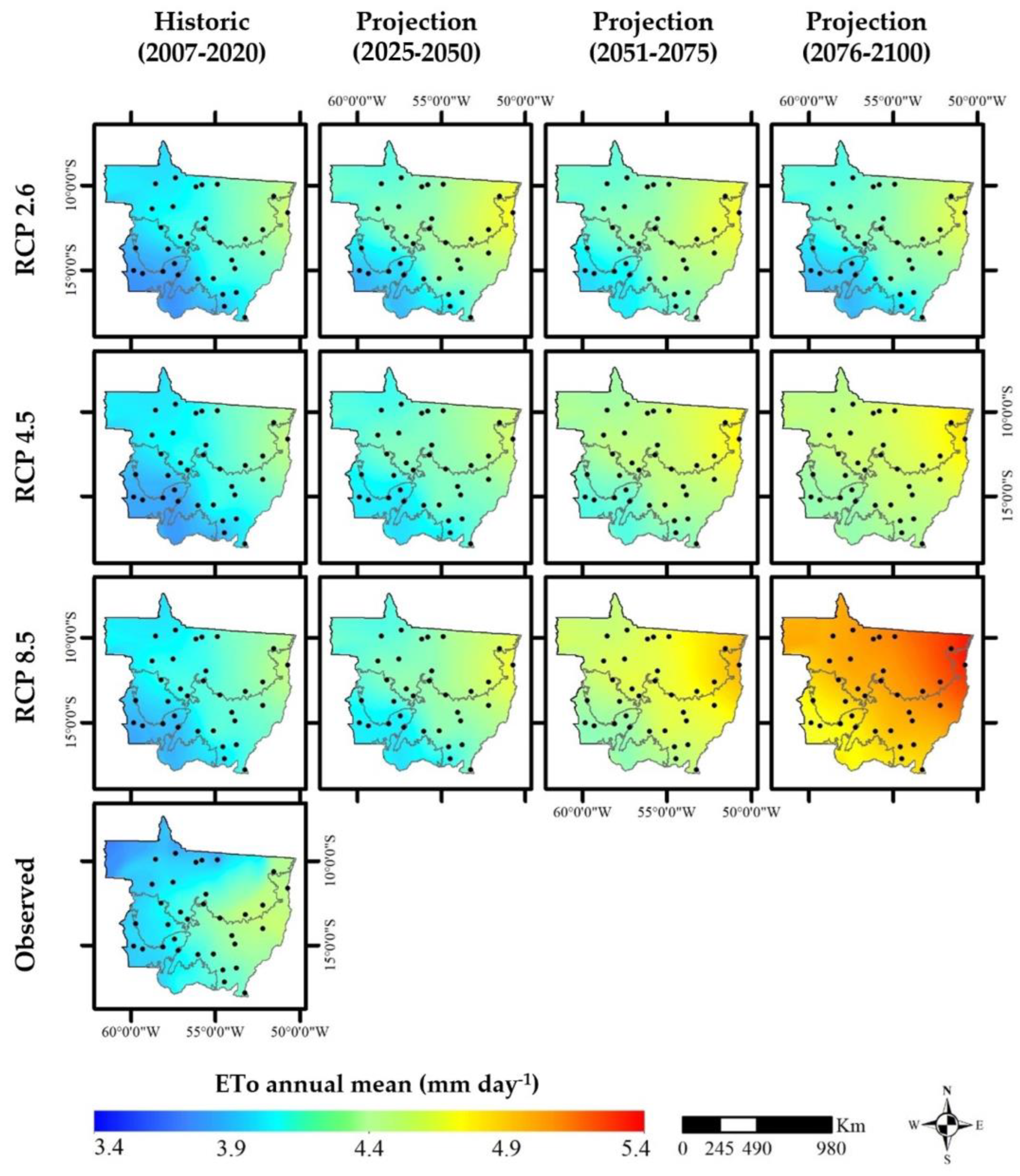
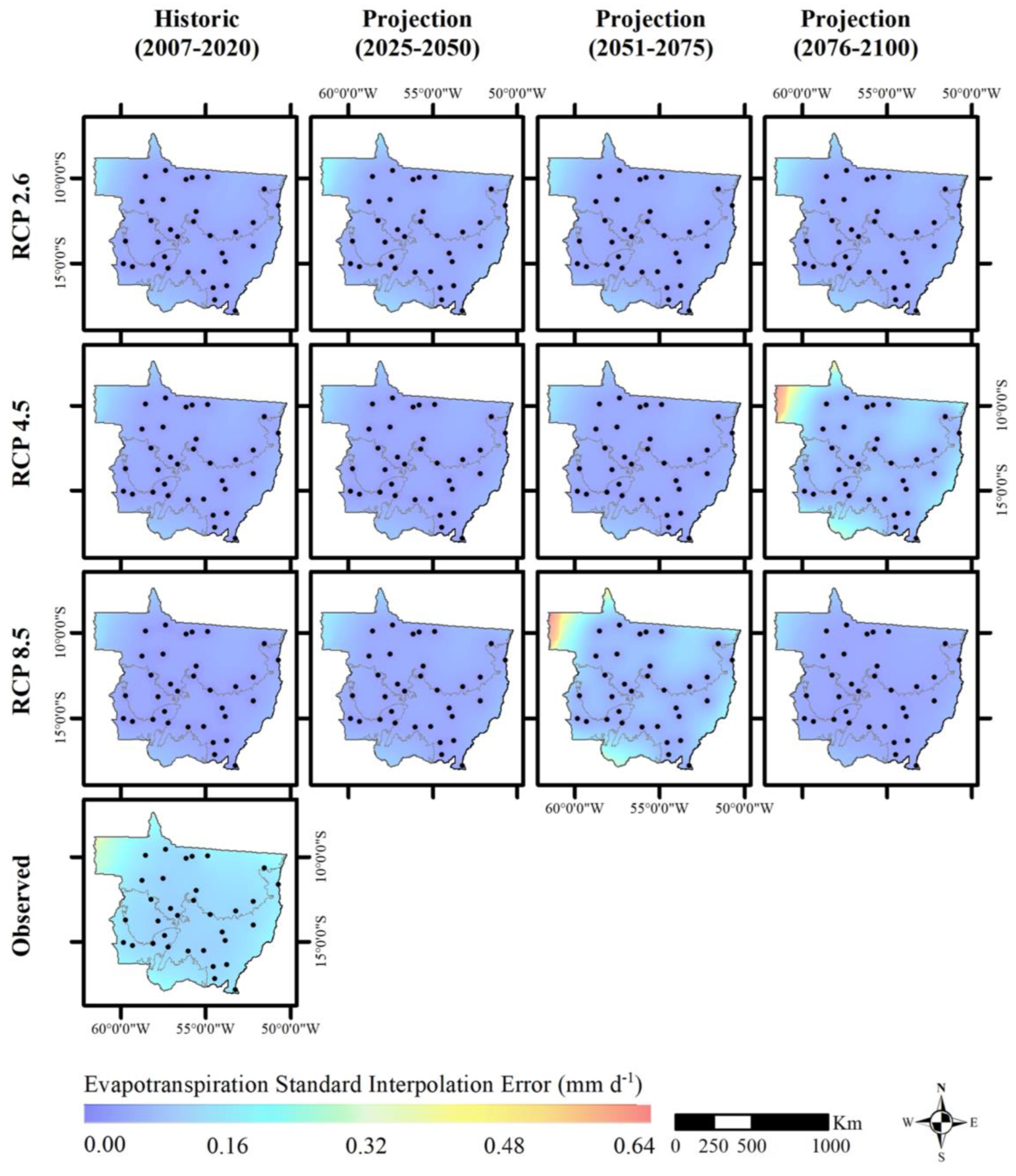
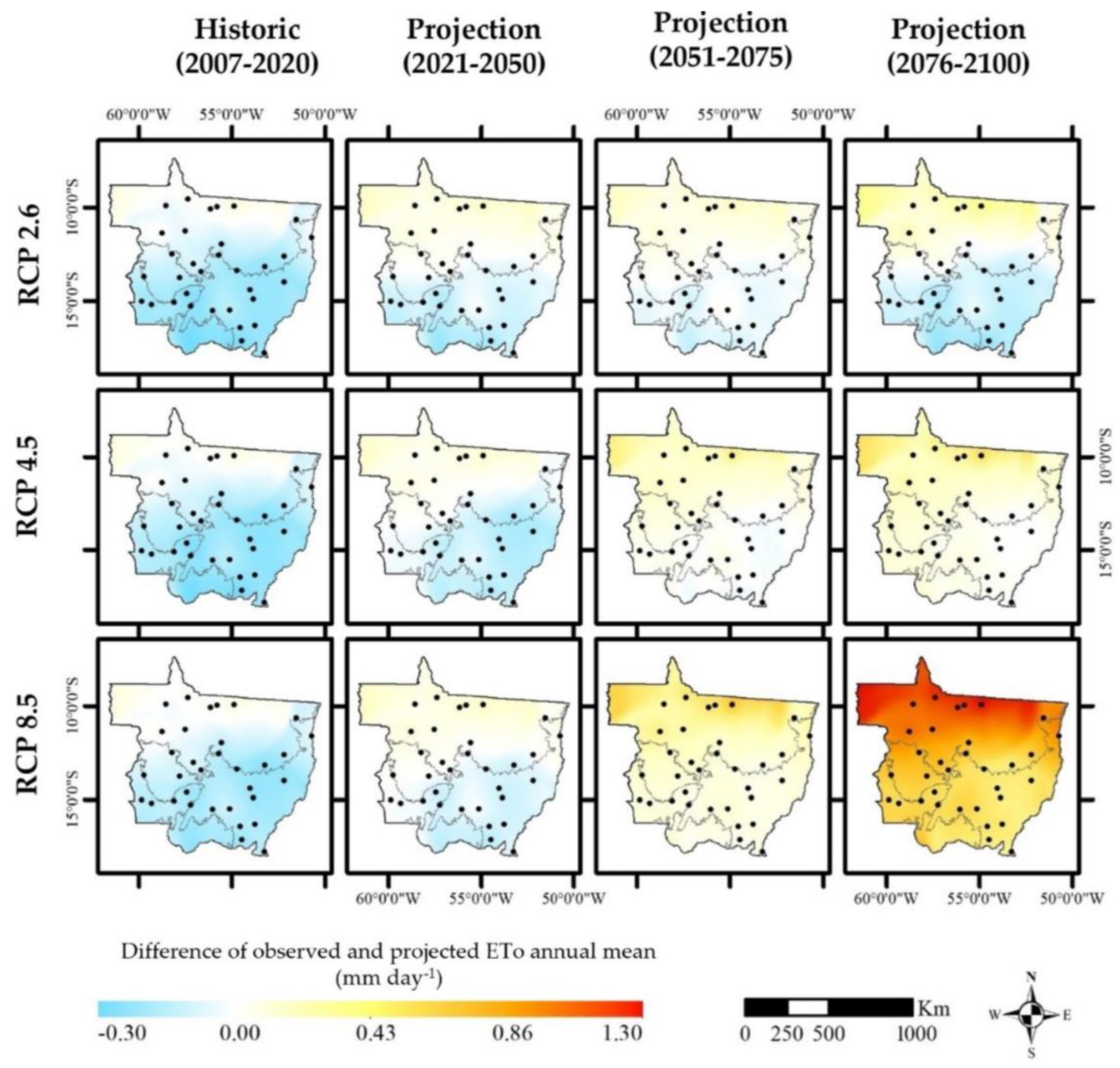

| GCM | Research Group | Resolution (Lat. × Lon.) |
|---|---|---|
| BNU-ESM | College of Global Change and Earth System Science, Beijing Normal University, China | 2.8 × 2.8 |
| CESM1-CAM5 | Community Earth System Model Contributors, USA | 1.25 × 0.94 |
| CNRM-CM5 | National Center of Meteorological Research, France | 1.4 × 1.4 |
| CSIRO-Mk3 6.0 | Organization/Queensland Climate Change Center of Excellence, Australia | 1.8 × 1.8 |
| GFDL-CM3 | NOAA Geophysical Fluid Dynamics Laboratory, USA | 2.5 × 2.0 |
| GFDL-ESM2G | NOAA Geophysical Fluid Dynamics Laboratory, USA | 2.5 × 2.0 |
| HadGEM2-ES | Met Office Hadley Center, UK | 1.88 × 1.25 |
| IPSL-CM5A LR | Institut Pierre Simon Laplace, France | 3.75 × 1.8 |
| IPSL-CM5A MR | Institut Pierre Simon Laplace, France | 2.5 × 1.25 |
| Eto (mm day−1) | Observed | RCP 2.6 | RCP 4.5 | RCP 8.5 |
|---|---|---|---|---|
| Actual (2007–2020) | 4.02 | 4.07 Aa | 4.13 Aa | 4.15 Aa |
| Projection (2025–2050) | 4.33 Aab | 4.27 Aa | 4.31 Aa | |
| Projection (2051–2075) | 4.37 Ab | 4.42 ABb | 4.56 Bb * | |
| Projection (2076–2100) | 4.19 Aab | 4.48 Bb * | 4.94 Cc * |
| Database | Period | Scenarios | Variables | |||||
|---|---|---|---|---|---|---|---|---|
| SRD | RH | Tmax | Tmin | WS | ETo | |||
| Observed | Short term (2007–2020) | Actual | −0.109 | −0.276 | 0.567 ** | 0.220 | −0.111 ** | −0.035 |
| Simulated | Short term (2007–2020) | RCP 2.6 | 0.731 ** | −4.709 ** | 2.141 ** | 1.216 ** | 0.016 | 0.423 ** |
| RCP 4.5 | −0.288 | −0.204 | 0.768 | 0.651 ** | −0.024 | 0.051 | ||
| RCP 8.5 | 0.047 | −1.211 | 0.683 * | 0.587 ** | 0.047 ** | 0.075 | ||
| Long term (2007–2100) | RCP 2.6 | 0.006 | −0.084 | 0.080 ** | 0.058 ** | 0.005 ** | 0.011 | |
| RCP 4.5 | 0.061 ** | −0.539 ** | 0.345 ** | 0.377 ** | 0.001 * | 0.055 ** | ||
| RCP 8.5 | 0.075 ** | −1.152 ** | 0.779 ** | 0.716 ** | 0.019 ** | 0.121 ** | ||
Disclaimer/Publisher’s Note: The statements, opinions and data contained in all publications are solely those of the individual author(s) and contributor(s) and not of MDPI and/or the editor(s). MDPI and/or the editor(s) disclaim responsibility for any injury to people or property resulting from any ideas, methods, instructions or products referred to in the content. |
© 2024 by the authors. Licensee MDPI, Basel, Switzerland. This article is an open access article distributed under the terms and conditions of the Creative Commons Attribution (CC BY) license (https://creativecommons.org/licenses/by/4.0/).
Share and Cite
Sabino, M.; da Silva, A.C.; de Almeida, F.T.; de Souza, A.P. Reference Evapotranspiration in Climate Change Scenarios in Mato Grosso, Brazil. Hydrology 2024, 11, 91. https://doi.org/10.3390/hydrology11070091
Sabino M, da Silva AC, de Almeida FT, de Souza AP. Reference Evapotranspiration in Climate Change Scenarios in Mato Grosso, Brazil. Hydrology. 2024; 11(7):91. https://doi.org/10.3390/hydrology11070091
Chicago/Turabian StyleSabino, Marlus, Andréa Carvalho da Silva, Frederico Terra de Almeida, and Adilson Pacheco de Souza. 2024. "Reference Evapotranspiration in Climate Change Scenarios in Mato Grosso, Brazil" Hydrology 11, no. 7: 91. https://doi.org/10.3390/hydrology11070091
APA StyleSabino, M., da Silva, A. C., de Almeida, F. T., & de Souza, A. P. (2024). Reference Evapotranspiration in Climate Change Scenarios in Mato Grosso, Brazil. Hydrology, 11(7), 91. https://doi.org/10.3390/hydrology11070091









